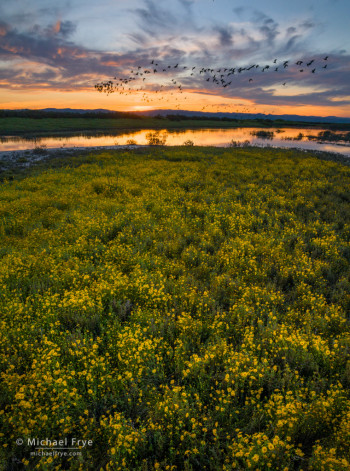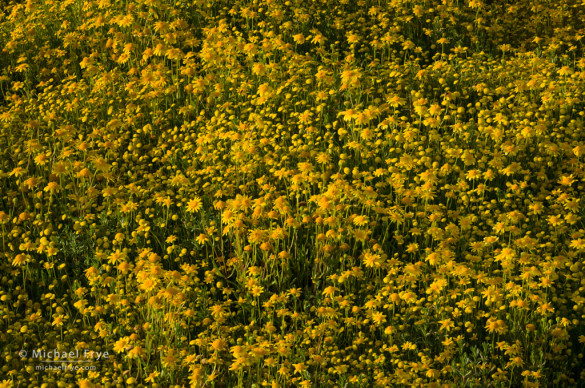There’s often an element of luck in landscape photography. Of course, as Ansel Adams said, “Chance favors the prepared mind.” You have to try to put yourself in the right place at the right time, and then make the most of the opportunities you get. But sometimes luck goes above and beyond.
Yesterday Claudia and I made a day trip to the Bay Area on business, and on our way home we decided to check out some vernal pools in the San Joaquin Valley. Vernal pools fill with water during the winter rainy season, and then slowly evaporate during the spring. As they evaporate, flowers grow along their shores, sometimes forming concentric rings of color. As California’s Central Valley got plowed and paved over, vernal pools became increasingly scarce, so they’re home to several rare species of plants and animals. Most of the remaining vernal pools can be found along the edges of the valley, where the land rises slightly, but the San Luis National Wildlife Refuge complex and Great Valley Grasslands State Park have preserved some vernal pools in the heart of the San Joaquin Valley, and that’s where we headed.
After some scouting we found carpets of goldfields lining a large vernal pool. The flowers were incredibly dense – a small sea of yellow. I found a variety of compositions (being careful to avoid stepping on my subjects), and then at sunset pointed the camera west toward some colorful clouds with a nice pattern of flowers in the foreground. The contrast was extreme, so I set the camera to bracket five frames, two stops apart, knowing that I’d probably have to blend two or three exposures together to get detail in foreground but avoid washing out the color in the clouds.
So far there was no great luck involved. I had been to this area before, and knew the general area to look for vernal pools and flowers. It wasn’t a spectacular sunset, though it certainly took a little luck to find any clouds at all. Then I saw a flock of white-faced ibises flying toward me from the right.
Claudia and I had seen two flocks of these birds fly by about ten minutes earlier, but I didn’t think it would happen again. Besides, those two flocks had flown by further east, behind me. This time they were on a trajectory to fly right through my frame. When I judged that the ibises were in the right position I pressed the shutter to start a bracketed sequence – only I forgot that the two-second self-timer was on, so the shutter didn’t fire until two seconds later. Ibises are very fast flyers, and they flew by me in a flash, so I was certain I’d missed them completely. Besides, the shutter speed would be way too slow – the birds would just be blurred streaks. Oh well. I was so certain that I’d missed them that I didn’t even bother to check the images on the back of the camera.
But when I looked through the photos later I was surprised to find that I had caught the birds perfectly. The second exposure of the bracketed sequence captured the ibises in a great position as they flew past the sunset, and that was also a good exposure for the sky. What’s more, that exposure was 1/250th of a second, fast enough to almost completely freeze their motion. There was a breeze, so I had pushed the ISO on my camera up to 800 in order to freeze the motion of the flowers. That made the bracketed sequence of shutter speeds 1/1000, 1/250, 1/60, 1/15, and 1/4 (the aperture was f/16). I used the second frame for the birds and sky, and blended that in Photoshop with the fourth frame for the foreground.
So I was lucky that there was a breeze, which forced me to raise the ISO and gave me a fast enough shutter speed to freeze the motion of the birds. The self-timer was also a piece of luck, because the right moment to press the shutter was apparently exactly two seconds after I actually pressed it. And of course it was lucky that the ibises flew through the frame at the perfect height during the peak of the sunset color. Quite a fortuitous combination.
Even without that exorbitant luck we would have had a great afternoon. Being out in this relatively natural, wild section of the Central Valley gave us a small glimpse of what this area must have been like 200 years ago. Back then grizzly bears and wolves roamed the valley, along with vast herds of elk and pronghorn, and enormous flocks of wintering waterfowl. And in the spring the valley was filled with flowers from one end to the other. Here’s John Muir’s description: “The valley of the San Joaquin is the floweriest place of world I ever walked, one vast, level, even flower-bed, a sheet of flowers, a smooth sea, ruffled a little in the middle by the tree fringing of the river and of smaller cross-streams here and there, from the mountains.”
— Michael Frye
P.S. Here’s another photo from yesterday afternoon, and a video that Claudia captured of ibises flying by earlier.
(If you can’t see the video click here.)
Related Posts: Courting Luck: How to Take Advantage of Special Light and Weather in Landscape Photography; Courting Luck, Part 2: Adapting Your Composition to the Conditions
Did you like this article? Click here to subscribe to this blog and get every new post delivered right to your inbox!
Michael Frye is a professional photographer specializing in landscapes and nature. He is the author or principal photographer of The Photographer’s Guide to Yosemite, Yosemite Meditations, Yosemite Meditations for Women, Yosemite Meditations for Adventurers, and Digital Landscape Photography: In the Footsteps of Ansel Adams and the Great Masters. He has also written three eBooks: Light & Land: Landscapes in the Digital Darkroom, Exposure for Outdoor Photography, and Landscapes in Lightroom: The Essential Step-by-Step Guide. Michael has written numerous magazine articles on the art and technique of photography, and his images have been published in over thirty countries around the world. Michael has lived either in or near Yosemite National Park since 1983, currently residing just outside the park in Mariposa, California.
Did you like this article? Click here to subscribe to this blog and get every new post delivered right to your inbox!
Michael Frye is a professional photographer specializing in landscapes and nature. He is the author or principal photographer of The Photographer’s Guide to Yosemite, Yosemite Meditations, Yosemite Meditations for Women, Yosemite Meditations for Adventurers, and Digital Landscape Photography: In the Footsteps of Ansel Adams and the Great Masters. He has also written three eBooks: Light & Land: Landscapes in the Digital Darkroom, Exposure for Outdoor Photography, and Landscapes in Lightroom: The Essential Step-by-Step Guide. Michael has written numerous magazine articles on the art and technique of photography, and his images have been published in over thirty countries around the world. Michael has lived either in or near Yosemite National Park since 1983, currently residing just outside the park in Mariposa, California.











Michael,
Wonderful post, as usual. I believe it was Louis Pasteur who first made the statement “Chance favors the prepared mind.”
Thanks Gary. I did properly attribute the quote in the P.P.S. to this post…
https://www.michaelfrye.com/2013/11/13/courting-luck/
… but didn’t feel like getting into the history of it here. 🙂 Pasteur actually said “In fields of observation, chance favors only the prepared mind.”
Sounds like a wonderful day out! It’s good to be lucky like that.
It was a wonderful day Vivienne, and yes, it’s always good to be lucky!
Beautiful Michael! I love that quote by John Muir. If I had a time machine I’d love to see the Valley before Europeans arrived. I just got back from Vernal pool hunting myself. I’m blown away by how many wildflowers there are this year. A bit more rain than the last few years makes such a huge difference.
Thanks Elizabeth! There’s another wonderful (and famous) quote by Muir about his first view of the Central Valley and the Sierra. You’ve probably read it before, but it’s always worth seeing again. It’s the first one on this page:
http://vault.sierraclub.org/john_muir_exhibit/questions_and_answers/#wildflowers
That is a great shot of a vernal pool, Michael. I’d say there was much more skill than luck involved in making this so superb.
Thanks John! Skill maybe in finding the place and composition, exposure and blending. But the birds were pure luck. 🙂
Michael,
Skill for sure! A little luck, maybe.
Cheers,
Alyn
Thanks Alyn! The birds were complete luck. The rest I’ll take some credit for.